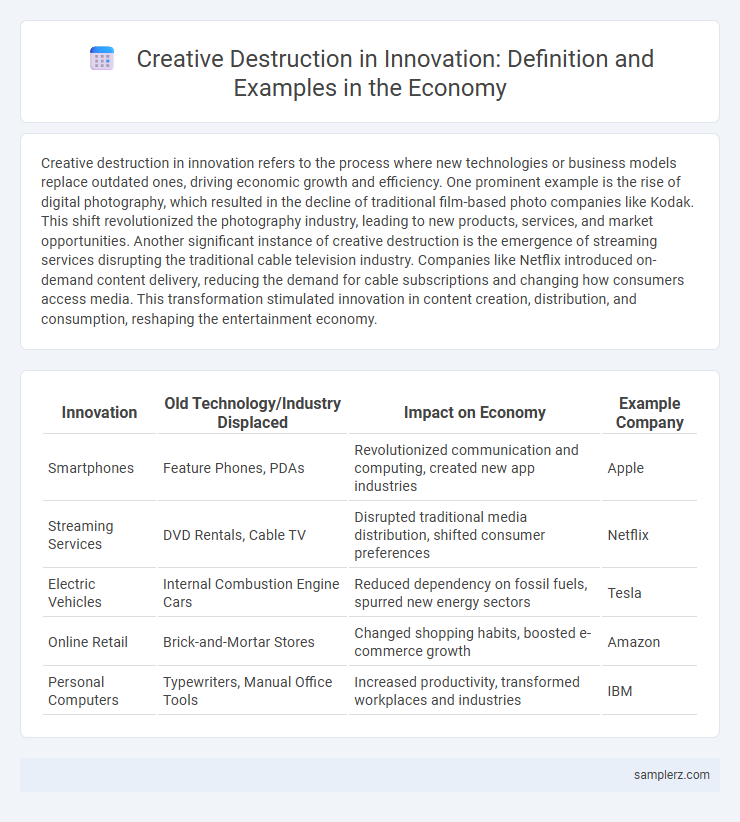Creative destruction in innovation refers to the process where new technologies or business models replace outdated ones, driving economic growth and efficiency. One prominent example is the rise of digital photography, which resulted in the decline of traditional film-based photo companies like Kodak. This shift revolutionized the photography industry, leading to new products, services, and market opportunities. Another significant instance of creative destruction is the emergence of streaming services disrupting the traditional cable television industry. Companies like Netflix introduced on-demand content delivery, reducing the demand for cable subscriptions and changing how consumers access media. This transformation stimulated innovation in content creation, distribution, and consumption, reshaping the entertainment economy.
Table of Comparison
| Innovation | Old Technology/Industry Displaced | Impact on Economy | Example Company |
|---|---|---|---|
| Smartphones | Feature Phones, PDAs | Revolutionized communication and computing, created new app industries | Apple |
| Streaming Services | DVD Rentals, Cable TV | Disrupted traditional media distribution, shifted consumer preferences | Netflix |
| Electric Vehicles | Internal Combustion Engine Cars | Reduced dependency on fossil fuels, spurred new energy sectors | Tesla |
| Online Retail | Brick-and-Mortar Stores | Changed shopping habits, boosted e-commerce growth | Amazon |
| Personal Computers | Typewriters, Manual Office Tools | Increased productivity, transformed workplaces and industries | IBM |
Introduction to Creative Destruction in Innovation
Creative destruction drives economic growth by continuously replacing outdated technologies with innovative advancements. A prime example is the transition from landline telephones to smartphones, which revolutionized communication and disrupted traditional telecommunication industries. This process fosters efficiency, encourages competition, and unleashes new business opportunities in dynamic markets.
The Role of Creative Destruction in Economic Growth
Creative destruction drives economic growth by enabling new industries to replace outdated ones, fostering innovation and increasing productivity. Notable examples include the transition from horse-drawn carriages to automobiles and the rise of digital photography overtaking traditional film. This continuous cycle accelerates technological progress, reallocating resources to more efficient enterprises and stimulating long-term prosperity.
Historical Examples of Creative Destruction
The invention of the steam engine during the Industrial Revolution exemplifies creative destruction by rendering traditional handcrafting methods obsolete and propelling mechanized manufacturing. Similarly, the rise of the digital camera replaced film photography, revolutionizing the imaging industry and leading to the decline of film-based companies like Kodak. The advent of the internet disrupted numerous sectors, such as retail and media, by shifting consumer behavior towards e-commerce and digital content, forcing legacy businesses to adapt or exit the market.
Technological Innovation Disrupting Traditional Industries
The rise of smartphones revolutionized communication, rendering traditional landline telephony obsolete through rapid technological innovation. Ride-sharing platforms like Uber disrupted the taxi industry by leveraging mobile apps and real-time data, transforming urban transportation. Renewable energy advancements, such as solar and wind technologies, have disrupted coal and fossil fuel sectors by offering more sustainable and cost-effective alternatives.
Creative Destruction in the Digital Economy
Creative destruction in the digital economy is exemplified by the rise of streaming services like Netflix, which disrupted traditional cable television and DVD rental businesses. Digital platforms such as Amazon transformed retail by replacing brick-and-mortar stores with e-commerce, fundamentally altering consumer purchasing behaviors. The continuous innovation in cloud computing and artificial intelligence drives the replacement of legacy IT infrastructure, enabling faster, scalable, and more cost-effective business solutions.
Startups Driving Market Transformation
Startups exemplify creative destruction by introducing disruptive technologies that render existing products and business models obsolete, thereby accelerating market transformation. Companies like Airbnb revolutionized the hospitality industry by leveraging digital platforms to replace traditional hotel services. This continuous cycle of innovation drives economic growth and reshapes competitive landscapes.
Case Study: Creative Destruction in Retail
The rise of e-commerce giants like Amazon exemplifies creative destruction in retail by disrupting traditional brick-and-mortar stores, leading to widespread closures and a redefinition of consumer shopping behaviors. This innovation has driven efficiency through advanced logistics, personalized marketing, and a vast product selection, forcing legacy retailers to adopt digital transformation strategies or face obsolescence. The shift highlights how technological advancement fosters economic evolution by reallocating resources from outdated business models to innovative, scalable platforms.
Impact on Employment and Workforce Dynamics
Creative destruction drives economic evolution by replacing outdated industries with innovative technologies, significantly altering workforce dynamics. Automation in manufacturing, a classic example, displaces routine jobs but simultaneously creates demand for skilled labor in tech development and maintenance. This transition requires continuous workforce adaptation through reskilling and upskilling to sustain employment and productivity growth.
Policy Implications and Regulatory Challenges
The process of creative destruction, exemplified by the rise of digital payment platforms replacing traditional banking, highlights significant policy implications such as the need for adaptive regulatory frameworks to foster innovation while ensuring consumer protection. Regulatory challenges include balancing market competitiveness with safeguards against systemic risks and addressing data privacy concerns in rapidly evolving technological landscapes. Policymakers must develop agile regulations that promote innovation-driven growth without stifling emerging industries or compromising financial stability.
Future Trends in Innovation-Driven Creative Destruction
Emerging technologies like artificial intelligence and blockchain are driving innovation-driven creative destruction by rendering traditional industries obsolete and enabling new market paradigms. Companies investing in renewable energy and electric vehicles are disrupting fossil fuel markets, highlighting a shift towards sustainable economic models. Future trends indicate accelerated cycles of innovation, where rapid digital transformation will continuously dismantle established business models while fostering startups and novel industries.

example of Creative destruction in innovation Infographic
 samplerz.com
samplerz.com